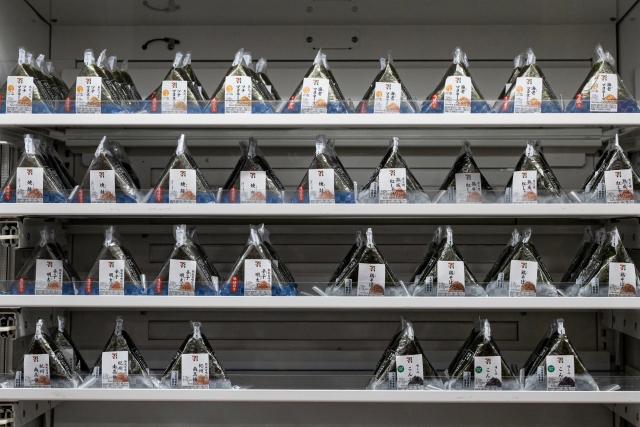
There’s a reason why this convenience store staple tastes different in these regions.
The other day, a programme on Japanese TV triggered a buzz on the Internet when it commented on the deliciousness of the Tuna Mayo onigiri rice ball from convenience store chain Family Mart.
People online piped up to say the reason why the rice ball seemed especially delicious was likely because it was purchased in Kansai (the region in and around Osaka). This sparked off a whole discussion around rice balls from the top three convenience store chains, Family Mart, Lawson and 7-Eleven, and how they taste different in Kansai and Kanto (the region in and around Tokyo).
So…what makes them taste different?
Well, according to 7-Eleven, it’s all to do with the seaweed. To find out more, our reporter Egawa Tasuku decided to take a trip down to Kyoto, one of the biggest cities in Kansai, and he made sure to take a supply of Tokyo-bought 7-Eleven rice balls with him for a comparison taste test.
After stepping out of Kyoto Station and admiring the glow of Kyoto Tower at night, Tasuku made his way to his hotel, stopping off at a nearby 7-Eleven to pick up some local rice balls.
▼ Ah, the understated beauty of a shelf of perfectly arranged onigiri…
Tasuku bought the same five varieties that he’d bought in Tokyo, and once he arrived at his hotel room for the night, he laid them all out under the unforgiving glare of the overhead light.
He picked up a Kyoto-born rice ball in “Salmon Flakes” flavour, and that’s when something on the packaging caught his eye.
Taking a closer look, he saw it was true — this little message in red-and-white read “seasoned seaweed“!
You don’t see this message on rice balls in the Kanto region, where onigiri are made with unseasoned seaweed. Tasuku usually eats his onigiri in Kanto, so he wasn’t sure what to expect with this seasoned seaweed version, but he eagerly unwrapped the morsel and immediately noticed that…
▼ …the seaweed was actually sticky beneath his fingers.
Ignoring that for a moment, he took a bite of the rice ball and was pleased to find that his first mouthful turned out to be a surprisingly flavourful experience. The compatibility between grilled salmon and seasoned seaweed was really good. Really, really good.
As far as rice balls go, Tasuku felt that this Kansai one tasted more luxurious than the ones he usually eats back home. However, one small thing he couldn’t ignore was the stickiness of the seaweed, which meant he ate his next rice ball with part of the wrapper still on.
Even then, he couldn’t escape the stickiness, as there was no real way to eat the onigiri properly without touching the surface of the seaweed. One wet wipe wasn’t even enough to wipe the stickiness away either, which means if you were eating these rice balls outdoors, you’d want to make sure you had a few wet wipes with you.
Tasuku wondered if he should eat the remaining rice balls with a knife and fork, as that would be the only way to save his hands from the annoying stickiness. Instead, he decided to take a deep breath and just go with the flow, allowing his hands to be sticky as he tried the rest of them, all while trying his hardest to ignore the sticky sensation on his skin.
So how did they taste? Well, Tasuku was surprised that the compatibility between seasoned seaweed and filling wasn’t always that great. Out of all of them, the Salmon Flakes definitely tasted better with the seasoned seaweed, and the Prawn Mayo as well, but when it came to the Tuna Mayo, Tasuku felt it was a tie between both the seasoned and unseasoned versions.
For the Spicy Cod Roe, though, Tasuku found that the unseasoned seaweed was a better fit, as the seasoned seaweed interfered with the flavour of the filling, which was already spicy and flavourful on its own.
As for the Fermented Salmon (bottom in the images below), Tasuku noticed that they were both unseasoned, which means you can buy unseasoned seaweed in Kansai if that’s more to your liking. However, it means Tasuku wasn’t able to compare them this time, as he didn’t have the seasoned version.
So, to summarise the results, Tasuku felt that the seasoned seaweed was great for some fillings and not so great with others, but in the end, it was ultimately undone by its inescapable stickiness. For Tasuku, the difference in flavour wasn’t great enough to account for the annoyance of being left with sticky fingers after eating, and he was thankful for the fuss-free eating style afforded by the non-sticky Tokyo rice balls.
After taking a look online to find out why the rice balls were different in different regions, Tasuku found that 7-Eleven was quoted as saying it’s all due to the different preferences in local tastes.
After a further inspection at Kyoto Convenience stores the following day, Tasuku confirmed that the seasoned seaweed rice balls aren’t just limited to 7-Elevens in the region, but Lawsons and Family Marts as well.
▼ The red-and-white labels on both read: “seasoned seaweed”.
So next time you’re visiting Kansai, be sure to stop by a convenience store and give their onigiri rice balls a try. It’s a great way to find out if your palate is more attuned to Kansai tastes or Kanto tastes, and if you stop by this Family Mart in Kyoto, you’ll be able to pair your rice balls with a glass of Japanese whisky, for a truly unforgettable experience!
Photos ©SoraNews24
● Want to hear about SoraNews24’s latest articles as soon as they’re published? Follow us on Facebook and Twitter!
[ Read in Japanese ]